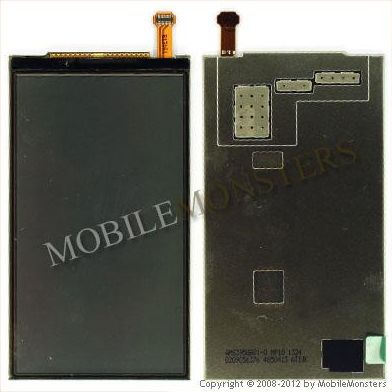Display change
In our modern world it is impossible to present life without a mobile telephone. This miracle of technique became inalienable part of everybody. Audio and video player, organizer, photo and video camera, playing prefix - all these and the great number of other functions executes a nowaday mobile telephone. Now this is so multifunction device that without problems replaces a few different gadgets and is similar to mini-computer.
Too frequent usage of mobile phone leads to loss of function. Eventually wear out some details, such as: keyboard, flex, buttons and touch screen. No one mobile phone is immune from falling or other mechanical damage. Therefore, the most common type of repair is display repair or replacement of the display.
Today are mobile phones of three different types of display.
- - Liquid crystal display (LCD)

LCD display it is a flat display on the basis of liquid crystals, which is used for the reflection of graphic or text information in mobile phones.
LCD displays consist of the following parts: liquid-crystal matrix (glass plate, where between layers are placed liquid crystals with light filter, that either run through a filter or not), illumination system, contact plait (flex) and frame (usually a plastic setting with metal frame).
How does LCD display work? Matrix points with liquid crystals doesn’t shine, but, depending on the given voltage on them, they are fully opened for the light transmission, partly opened or fully closed in case of reflection of dark part of image. Opened liquid-crystal points are illuminating from beneath, whereupon a concrete image appears on the screen.
Approximately 10 years ago such type of screen had more advantages, than defects. The main advantages of this display were his compactness, absence of twinkling, preciseness and image brightness. But some time after the new generation of displays have been produced in market, that’s why LCD displays have more defects now.
LCD display’s thickness was the main merit some years ago, but now it is one of important demerits of these displays’ type. Now there are displays thinner, than liquid-crystal.
Second significant LCD display’s disadvantage is his disability to show absolutely black image. In order to receive a dark image it is necessary to give a high voltage on liquid crystals, which will block a white light from illumination (light-emitting diodes), what lead to high power consumption and considerably waste supply of storage battery.
LCD displays’ image depend on corner vision. Turning a telephone under any corner on a vertical line or horizontal, there is possibility of poor vision of image.
Another disadvantage of LCD display is that at the hit of moisture to the display, there appear spots, which disturb display’s efficiency and as a result a mobile phone needs a display change.
Despite all disadvantages of these displays, they are in popular demand until now. Due to long-term experience of the use and not high cost of production many representatives of mobile telephones prefer to set LCD displays.
- - AMOLED display (Matrix Organic Light-Emitting Diode)

AMOLED technology implies using of organic light-emitting diodes as light-emitting elements and active matrix for a light-emitting diodes’ management. Organic light-emitting diodes it is molecules, which are capable to emit a light during the electric current flowing and to change the intensity of colors depending on amount of current.
AMOLED displays are able to represent a large color gamut, have a heightened brightness, and also high contrast of image, unlike a predecessor LCD display.
Comparing with LCD displays, basic AMOLED display’s merits are his transparence, minimum thickness and absence of necessity of illuminating from beneath that considerably reduce power consumption.
AMOLED display’s image doesn’t depend on vision corners, unlike the displays of other technologies. They differ in wonderful visibility under any corner on a vertical or horizontal. Also AMOLED displays have a possibility to represent absolutely black picture, because there no necessity to block a light from illuminating from beneath.
In spite of all AMOLED display’s advantages, there are some weak points. One basic defect is diminution of service life during active work in bright tones, therefore color rendition will be violated in time.
High AMOLED displays’ production price prevent in more active sales promotion to the market, therefore AMOLED display change will be more expensive than LCD display change.
- - Super AMOLED display (Super Active Matrix Organic Light-Emitting Diode)
How does the construction of Super AMOLED display look like? The epiphase of this display is touchscreen. He is glued to the transparent protective layer, there wiring is located. Wiring is a wire network for the transmission of low tension current. Wiring goes to the layer with light-emitting diodes, and then they form an image.
Super AMOLED display it is an improved technology of AMOLED display. The difference consists in another organization of displays. During AMOLED display making there are few layers, between that there is one more layer – an air layer. But in Super AMOLED display only one layer, touchscreen is glued to the display that allows to get rid from the layer of air. This display’s construction allows obtaining a greater brightness, possibility to read in the sun, preciseness and thinness of display. In an interval between display and touchscreen cannot get a dust, because there is not an air gap. An image doesn’t depend on a vision corner due to a brightness and preciseness of display.
Along with dignities there are a few defects. A basic defect is a high production cost, that influences on the price of display and accordingly on display repair.
Second important disadvantage of display is gradual burning down of organic light-emitting diodes. Middle service life of such display is approximately 6-10 years. The decision of this problem is display change.
Despite some shortcomings, lately Super AMOLED displays became very popular. Mobile phones with such type of display are produced more often than other. If a display nevertheless stop working or broke up, display change must be produced immediately.
How does display change look like?
In order to get to the screen it is necessary to disassemble a mobile phone. To do this, remove the back cover of the phone, the battery and SIM – card. Little screws that hold the front and back corps of telephone are untwisted. After it, it is possible to take off the back corps of mobile telephone.
Only when back of the phone is taken off, carefully put aside system board and a flex is pulling out of the socket. This procedure is needed in an order to separate the front part from the main part of the phone.
When display is disconnected from a system board, he is ready to the extraction. It is necessary carefully to extract a display from a corps with pincers help, not to injure other details.
The prepared display and system board must be placed back in a corps, attaching the flex of display to the board. After this procedure failing details are placed back to the corps: microphone, buttons and keyboard. Need to check the efficiency of new detail, before the phone will be gathered completely. To do this, the battery is connected to the system board and phone must be turned on. If the display correctly shows an image, the detail is correctly installed. Only after careful verification it is possible to gather the phone. At the end of mobile phone’s repair it must be tested one more time. Only after complete inspection we can say confidently that the display change has been completed successfully.
Principle of defective AMOLED display change is identical to the principle of LCD display change. But in some last models of mobile phone display change is considerably simplified, because display and touchscreen is one general module. It is not necessary to spend a lot of time on complete disassembling of phone, because there isn’t a necessity to separate display, touchscreen and phone’s corps.
It is necessary to put missing details from old module to the prepared module, such as: speaker, antenna, flex of system connector and decorative buttons. Then system board is put in module, display’s flex is attached to the display and back lid of phone is screwed on corps. In completion of repair it is necessary to check a new detail: turn on phone and see, does the screen respond to click; does the display correctly show an image, do the decorative buttons work; is there any sound. If all works correctly, display change is successfully completed.
- - Super AMOLED display change
AMOLED display is a prototype of Super AMOLED display, therefore principle of display change will be the same, as AMOLED display change. Difference is only in one moment – AMOLED display change will be made by two methods: only display change or all module change, depending on a mobile phone. But in new generation mobile phones with Super AMOLED, display change goes by the second method – all module is changed, which consists of display, touchscreen and protective corps. It is necessary to put missing details from old module to the prepared module, such as: speaker, antenna, flex of system connector and decorative buttons. Then system board is put in module, display’s flex is attached to the display and back lid of phone is screwed on corps. Then it is possible to check functionality of mobile phone. If all work correctly, display change successfully completed.
However mobile phones are very complicated device, all mobile phones’ brands have their own frills, therefore the best decision in case of phone’s defects will be repair in service center. You will economize your finances, time and nerves. And You will get a guarantee of quality repair.
Our Service Center works for you and your mobile phone.